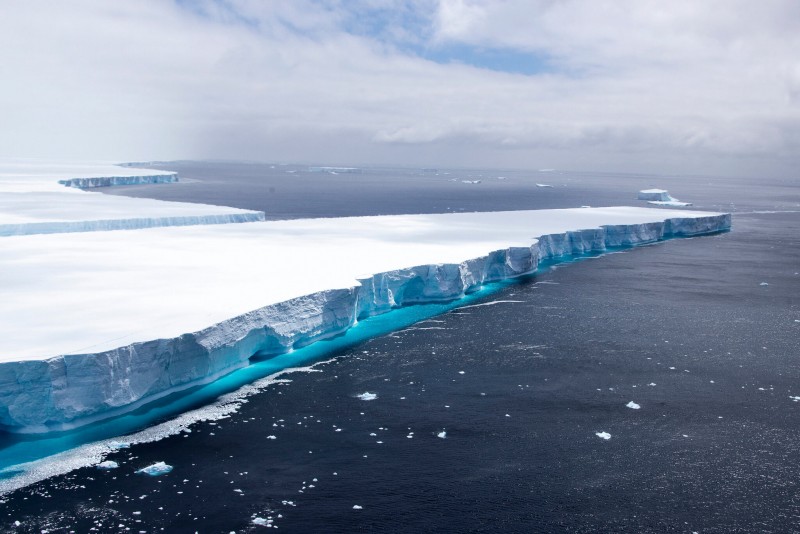
As the world grapples with the relentless challenges posed by climate change, a new and colossal phenomenon is capturing global attention – the movement of the world's largest iceberg. In this comprehensive exploration, we aim to unravel the potential consequences of this massive iceberg and ponder a critical question: Will cities situated on the seashore disappear?
The awe-inspiring spectacle of glacial calving has set in motion unprecedented shifts in glacial dynamics. This colossal iceberg, detached from its glacial origin, is making its way through the polar waters, leaving scientists and researchers astounded by the sheer scale of its movement.
A global effort is underway as scientists and researchers diligently track the movements of this immense iceberg. Cutting-edge technology, satellite imagery, and on-the-ground monitoring contribute to a comprehensive understanding of its trajectory, allowing for more accurate predictions and assessments of potential impacts.
The iceberg's movement raises alarms about rising sea levels, posing a severe threat to coastal communities worldwide. As the iceberg melts, the infusion of colossal amounts of water into the oceans heightens the risk of inundation, jeopardizing the very existence of low-lying coastal areas.
Delving into the vulnerability of cities situated on the seashore, we identify regions at the forefront of this risk. Urban centers with inadequate infrastructure and insufficient preparedness face the brunt of the potential consequences, urging the need for strategic planning and immediate action.
The iceberg's movement intersects with the broader challenge of climate change, amplifying the threats faced by coastal regions. The warming of the planet accelerates glacial melting, and the colossal iceberg's journey becomes emblematic of the larger environmental crisis unfolding.
The implications of melting ice extend far beyond the immediate vicinity of the iceberg. As ice sheets diminish, global sea levels rise, impacting coastlines and ecosystems around the world. This interconnected web of consequences underscores the urgent need for a collective, international response to climate change.
With cities in jeopardy, there is an urgent call for implementing effective mitigation strategies. Governments, communities, and environmental organizations must collaborate to reduce carbon emissions, slow the pace of global warming, and mitigate the specific risks posed by the iceberg's movement.
Communities must adopt adaptive measures to enhance coastal resilience in the face of the iceberg's movement. This involves strategic urban planning, the development of robust infrastructure, and the implementation of early warning systems to minimize the impact on human settlements.
The potential economic fallout of coastal displacement is a pressing concern. The damage to infrastructure, loss of property, and disruption of economic activities in affected coastal areas necessitate a thorough examination of the economic ramifications and the development of financial mechanisms to address these challenges.
The insurance industry faces new challenges as natural disasters become more unpredictable. Insurers must reassess risk models, develop innovative coverage solutions, and collaborate with governments and communities to build resilience against the growing threat of environmental catastrophes.
Technological advancements play a pivotal role in accurately predicting the movements of the iceberg. From satellite-based monitoring to sophisticated modeling, these tools empower scientists to provide timely warnings and guide proactive measures to safeguard coastal communities.
The effectiveness of early warning systems in alerting coastal communities to potential dangers cannot be overstated. Investing in and improving these systems is crucial for minimizing the loss of life and property, offering a vital lifeline for communities facing the immediate impacts of environmental changes.
Highlighting the need for international collaboration, we explore how nations can come together to address climate-related challenges. Joint efforts, shared resources, and coordinated strategies are essential to mitigate the impacts of the iceberg's movement and tackle the broader issue of climate change.
Examining the significance of the Paris Agreement becomes imperative in the context of mitigating climate change and its impact on coastal regions. The accord serves as a foundation for collective action, emphasizing the importance of global cooperation in preserving the planet for future generations.
Navigating the delicate balance between conservation efforts and urban development is paramount. Striking a harmonious chord between preserving natural environments and meeting the needs of growing populations ensures sustainable coexistence along coastlines.
Proposing sustainable practices that can be implemented to ensure the coexistence of cities and their surrounding natural environments. From eco-friendly infrastructure to community-led conservation initiatives, these practices offer a roadmap for creating resilient and environmentally conscious coastal cities.
Amplifying the voices of individuals and communities directly affected by the iceberg's movements adds a human dimension to this environmental challenge. Understanding the experiences and perspectives of those on the frontline provides valuable insights into the human impact of global environmental changes.
Sharing stories of resilience and adaptation, we spotlight communities that have successfully faced the challenges posed by changing coastal dynamics. These narratives inspire collective action and serve as examples of how human ingenuity and community spirit can overcome environmental adversity.
With the threat looming large, there's an urgent call for immediate action to safeguard coastal cities and communities. Governments, businesses, and individuals must join forces to implement strategies that address the root causes of climate change and build resilience against its consequences.
In conclusion, we emphasize the collective responsibility we hold for future generations. Urging a united front against the challenges posed by environmental shifts, we recognize the pivotal role each individual and community plays in preserving the planet for the well-being of generations to come.
Cylinder exploded in Mumbai's Chembur area, More than 10 injured
Madhya Prades Election Exit Poll Result Date, Time and Watch
Red Hills Reservoir Gates Opened Amid Continued Chennai Rainfall